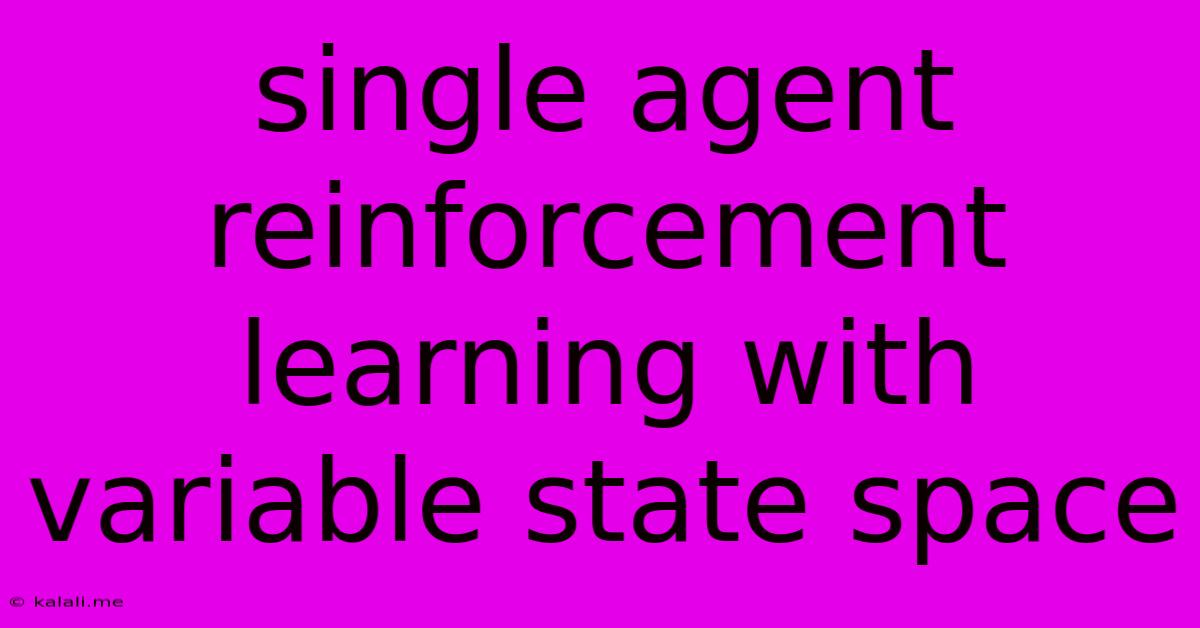Single Agent Reinforcement Learning With Variable State Space
Kalali
May 24, 2025 · 3 min read

Table of Contents
Single Agent Reinforcement Learning with Variable State Space: Navigating Complexity
Reinforcement learning (RL) has emerged as a powerful technique for training agents to make optimal decisions in dynamic environments. While many RL algorithms excel in scenarios with fixed state spaces, real-world problems often present a more challenging landscape: a variable state space. This article delves into the complexities of single-agent reinforcement learning when dealing with environments where the number of states can change over time. We will explore the challenges, potential solutions, and promising directions in this active area of research. Understanding this will be crucial for developing agents capable of tackling problems like dynamic resource allocation, personalized recommendations, and robotic control in unpredictable settings.
Understanding the Challenge: Variable State Spaces
In traditional RL, the agent operates within a defined set of states. This allows for the construction of tables or relatively straightforward function approximations to represent the value function or Q-function. However, a variable state space introduces significant complications:
-
State Representation: The very definition of the state may change. Imagine a robot navigating a warehouse; the number of items on shelves, their positions, and the robot's battery level all contribute to the state. These factors are dynamic, leading to a constantly evolving state space.
-
Scalability: As the number of states grows, traditional methods like Q-learning or SARSA become computationally intractable. The curse of dimensionality becomes even more pronounced.
-
Exploration-Exploitation Dilemma: The changing nature of the state space makes exploration significantly harder. An action that was optimal in one state configuration might be disastrous in another.
-
Generalization: An agent needs to generalize its learned behavior to unseen state configurations. This requires robust function approximation techniques that can adapt to the evolving nature of the state space.
Addressing the Challenges: Techniques and Approaches
Several approaches aim to mitigate the challenges posed by variable state spaces in single-agent RL:
-
Hierarchical Reinforcement Learning (HRL): Breaking down the complex task into subtasks with simpler, more manageable state spaces. This allows for learning reusable skills and policies at different levels of abstraction. The lower-level policies can adapt to local changes within their respective sub-spaces.
-
Memory-Augmented Neural Networks: Integrating external memory into neural network-based RL agents. This allows the agent to store and retrieve information about past states and transitions, improving generalization and enabling learning in environments with large or changing state spaces. Recurrent Neural Networks (RNNs) and Long Short-Term Memory (LSTM) networks are frequently employed for this purpose.
-
Function Approximation with Adaptive Architectures: Utilizing neural networks with architectures that can adapt to the changing dimensionality of the state space. This might involve techniques like dynamic network expansion or pruning to optimize the network size and complexity based on the current state.
-
State Abstraction: Developing methods to abstract away irrelevant details from the state representation. This reduces the effective size of the state space and makes learning more efficient. However, careful design is crucial to avoid losing crucial information.
Promising Directions and Future Research
Research in single-agent RL with variable state spaces is an active and rapidly evolving field. Some promising avenues for future research include:
-
Improved State Abstraction Techniques: Developing more sophisticated methods for automatically discovering relevant state features and abstracting away irrelevant information.
-
Transfer Learning: Leveraging knowledge learned in one environment or state configuration to accelerate learning in another.
-
Meta-Reinforcement Learning: Developing algorithms that can learn to learn, adapting quickly to new state space configurations and dynamics.
-
Online Learning and Adaptation: Developing algorithms that can continuously learn and adapt their policies as the state space changes over time.
Conclusion
Single-agent reinforcement learning with variable state spaces presents significant challenges but also offers exciting opportunities. By combining hierarchical approaches, memory-augmented networks, adaptive function approximation, and sophisticated state abstraction techniques, researchers are making strides toward developing agents capable of tackling increasingly complex real-world problems. Further research in these areas is crucial to unlock the full potential of RL in dynamic and unpredictable environments.
Latest Posts
Latest Posts
-
How To Remove Texture From Walls
May 24, 2025
-
How To Keep Pipes From Freezing Without Heat
May 24, 2025
-
Refrigerator Water Line Shut Off Valve
May 24, 2025
-
How To Replace A Faucet In The Bathtub
May 24, 2025
-
How Long Does It Take Concrete To Cure
May 24, 2025
Related Post
Thank you for visiting our website which covers about Single Agent Reinforcement Learning With Variable State Space . We hope the information provided has been useful to you. Feel free to contact us if you have any questions or need further assistance. See you next time and don't miss to bookmark.